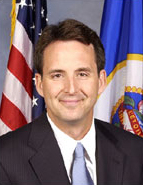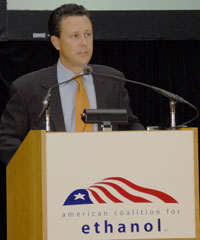Midwestern farmers are seeing a bit of a land boom.. as the rest of the country is facing a slumping real estate market. The difference? Farmland can grow corn, and corn can turn into ethanol.
This story in the New York Times says it’s good news for established farmers, but tough on new farmers looking to buy land:
Skyrocketing farmland prices, particularly in states like Illinois, Iowa and Nebraska, giddy with the promise of corn-based ethanol, are stirring new optimism among established farmers. But for younger farmers, already rare in this graying profession, and for small farmers with dreams of expanding and grabbing a piece of the ethanol craze, the news is oddly grim. The higher prices feel out of reach.
“It’s extremely frustrating,” said Paul Burrs, who farms about 400 acres near Dixon, Ill., and says he regularly bids on new farmland in the hopes of renting it. Mostly, he said, he loses out to higher bidders. “I crunch the numbers and go as high as I can. But then that’s it. There’s nothing more I can do.”
In central Illinois, prime farmland is selling for about $5,000 an acre on average, up from just over $3,000 an acre five years ago, a study showed. In Nebraska, meanwhile, land values rose 17 percent in the first quarter of this year over the same time last year, the swiftest such gain in more than a quarter century, said Jason R. Henderson, an economist at the Federal Reserve Bank in Kansas City.
A federal-government analysis of farm real estate values released Friday showed record average-per-acre values across the country. The analysis said property prices averaged $2,160 an acre at the start of 2007, up 14 percent from a year earlier.
The article goes on to say that some of the land boom is being credited to those folks from the cities fed up with the hassles and high taxes of urban living… as is the case just about every year. But this time, more of the buys are farmers trying to get more land to plant more corn and put up more grain bins to put this biggest harvest.


 Alan Eliot Goldberg, FAIA, a former design consultant to ExxonMobil, has developed a prototype station that embraces sustainable materials as well as solar power, which is used to create hydrogen fuel via electrolysis. Adapted from his Advanced Refueling Retail Center concept, it dispenses six different kinds of fuel. The 5,000-square-foot station will include a convenience store and an information center for hydrogen power. “If you’re introducing a new product, you should have a new concept,” Goldberg says of its design. Developed by the ARRC/H2 Alliance, the first station is planned for Syracuse, New York.
Alan Eliot Goldberg, FAIA, a former design consultant to ExxonMobil, has developed a prototype station that embraces sustainable materials as well as solar power, which is used to create hydrogen fuel via electrolysis. Adapted from his Advanced Refueling Retail Center concept, it dispenses six different kinds of fuel. The 5,000-square-foot station will include a convenience store and an information center for hydrogen power. “If you’re introducing a new product, you should have a new concept,” Goldberg says of its design. Developed by the ARRC/H2 Alliance, the first station is planned for Syracuse, New York.  Production has started at Iowa’s 13th biodiesel plant… this one, a Western Dubuque Biodiesel, LLC, plant near Farley.
Production has started at Iowa’s 13th biodiesel plant… this one, a Western Dubuque Biodiesel, LLC, plant near Farley.  While at the ACE Convention I got to meet fellow biofuels blogger Nathan Schock. Nathan is the public relations director for
While at the ACE Convention I got to meet fellow biofuels blogger Nathan Schock. Nathan is the public relations director for  As schools gear back up for another year, many of them will run their buses on biodiesel.
As schools gear back up for another year, many of them will run their buses on biodiesel. Some people at City Hall on Wednesday were excited about the plant, which could produce 320 million gallons per year of biodiesel fuel.
Some people at City Hall on Wednesday were excited about the plant, which could produce 320 million gallons per year of biodiesel fuel. Minnesota Governor Tim Pawlenty has announced a new initiative to move his state from using two percent to 20 percent biodiesel by 2015.
Minnesota Governor Tim Pawlenty has announced a new initiative to move his state from using two percent to 20 percent biodiesel by 2015. One of the relatively newer members of the staff of the
One of the relatively newer members of the staff of the  The executive vice president of the
The executive vice president of the  Attendance at the ACE Convention is a record with nearly 2,000 people here over the course of the event. Today is the final day and we’ll have a keynote address from South Dakota Senator John Thune soon.
Attendance at the ACE Convention is a record with nearly 2,000 people here over the course of the event. Today is the final day and we’ll have a keynote address from South Dakota Senator John Thune soon.